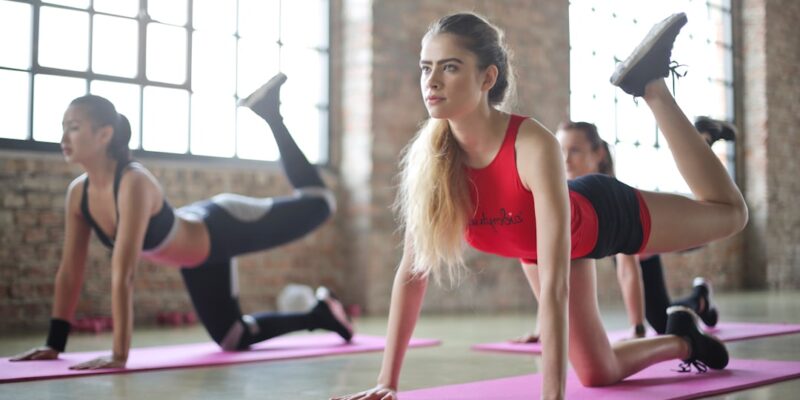
20-Minute Morning Workout Routine to Kickstart Your Day
Starting your day with a morning workout routine can have numerous benefits for both your physical and mental well-being. Not only does it help you kickstart your metabolism and burn calories throughout the day, but it also boosts your energy levels, improves your mood, and enhances your focus and productivity. In this article, we will explore the various benefits of a morning workout routine and provide you with tips and exercises to help you get started.
Key Takeaways
- A morning workout routine can provide numerous benefits, including increased energy, improved mood, and better sleep.
- Finding motivation for your morning workout can be achieved by setting goals, creating a routine, and finding an accountability partner.
- Dynamic stretching before exercise is important to prevent injury and improve performance.
- 20-minute cardio exercises, such as jumping jacks and high knees, can get your heart pumping and provide a quick and effective workout.
- Bodyweight exercises, such as squats and push-ups, can provide a full-body workout without the need for equipment.
The Benefits of a Morning Workout Routine
Working out in the morning has several physical and mental benefits. Firstly, it helps to jumpstart your metabolism, which means that you will continue to burn calories at a higher rate throughout the day. This can be particularly beneficial if weight loss or weight maintenance is one of your goals. Additionally, exercising in the morning can increase your energy levels for the rest of the day, making you feel more alert and focused.
Furthermore, engaging in physical activity in the morning has been shown to improve mood and reduce stress levels. Exercise releases endorphins, which are known as “feel-good” hormones that can help alleviate symptoms of anxiety and depression. Starting your day with a workout can also provide a sense of accomplishment and set a positive tone for the rest of the day.
How to Find Motivation for Your Morning Workout
Finding motivation to get out of bed and exercise in the morning can be challenging, especially if you’re not a morning person. However, there are several strategies you can use to help you stay motivated. Firstly, set realistic goals for yourself and remind yourself of why you want to exercise in the first place. Whether it’s to improve your health, lose weight, or simply feel better about yourself, having a clear purpose can help keep you motivated.
Another way to find motivation is by finding an exercise routine that you enjoy. If you dread going to the gym or running on a treadmill, try exploring different types of workouts such as yoga, dance classes, or outdoor activities like hiking or cycling. Finding an activity that you genuinely enjoy can make it easier to get out of bed and exercise in the morning.
The Importance of Dynamic Stretching Before Exercise
Before starting your morning workout, it’s important to warm up your muscles and prepare your body for physical activity. Dynamic stretching is a type of stretching that involves moving parts of your body through a full range of motion. It helps to increase blood flow to the muscles, improve flexibility, and reduce the risk of injury.
Some examples of dynamic stretches include arm circles, leg swings, walking lunges, and high knees. These stretches help to loosen up the muscles and joints, improve mobility, and activate the muscles that will be used during your workout. It’s important to perform dynamic stretches in a controlled manner and avoid any jerky or bouncing movements.
20-Minute Cardio Exercises to Get Your Heart Pumping
If you’re short on time but still want to get a good cardio workout in the morning, there are several exercises that you can do in just 20 minutes or less. High-intensity interval training (HIIT) is a great option for a quick and effective cardio workout. It involves alternating between short bursts of intense exercise and periods of rest or lower intensity.
Some examples of HIIT exercises include burpees, mountain climbers, jumping jacks, and squat jumps. These exercises can be done with little to no equipment and can be modified to suit your fitness level. The key is to push yourself during the intense intervals and give it your all for maximum cardiovascular benefits.
The Best Bodyweight Exercises for a Full-Body Workout
Bodyweight exercises are a great way to build strength and tone your muscles without the need for any equipment. They can be done anywhere, including in the comfort of your own home. Here are some bodyweight exercises that target different muscle groups:
1. Push-ups: This exercise targets the chest, shoulders, and triceps. Start in a high plank position with your hands slightly wider than shoulder-width apart. Lower your body until your chest nearly touches the floor, then push back up to the starting position.
2. Squats: Squats target the muscles in your lower body, including the quadriceps, hamstrings, and glutes. Stand with your feet shoulder-width apart, then lower your body as if you’re sitting back into a chair. Keep your chest up and your knees in line with your toes.
3. Lunges: Lunges work the muscles in your legs and glutes. Start by standing with your feet hip-width apart. Take a big step forward with your right foot and lower your body until both knees are bent at a 90-degree angle. Push through your right heel to return to the starting position, then repeat on the other side.
4. Plank: Planks are a great exercise for strengthening your core muscles. Start in a high plank position with your hands directly under your shoulders and your body in a straight line from head to toe. Hold this position for as long as you can while maintaining proper form.
Incorporating Resistance Bands for Added Intensity
Resistance bands are a versatile and affordable piece of equipment that can be used to add intensity to your workout. They come in different levels of resistance, so you can choose one that suits your fitness level. Here are some exercises that can be done with resistance bands:
1. Banded squats: Place a resistance band around your thighs, just above your knees. Stand with your feet shoulder-width apart and toes slightly turned out. Lower into a squat while keeping tension on the band, then push through your heels to return to the starting position.
2. Banded glute bridges: Lie on your back with a resistance band around your thighs, just above your knees. Bend your knees and place your feet flat on the floor. Lift your hips off the ground, squeezing your glutes at the top, then lower back down.
3. Banded lateral walks: Place a resistance band around your ankles. Stand with your feet hip-width apart and knees slightly bent. Take a step to the side with your right foot, then follow with your left foot. Continue stepping sideways for a set number of reps, then switch directions.
4. Banded rows: Anchor a resistance band to a sturdy object at chest height. Hold the ends of the band with your palms facing each other and step back to create tension. Pull the band towards your chest, squeezing your shoulder blades together, then slowly release back to the starting position.
Core Strengthening Exercises for a Stronger Midsection
A strong core is essential for stability and proper posture. Here are some exercises that target the core muscles:
1. Plank variations: In addition to the standard plank, there are several variations that can challenge your core muscles in different ways. These include side planks, plank jacks, and plank with knee tucks.
2. Russian twists: Sit on the floor with your knees bent and feet flat on the ground. Lean back slightly and lift your feet off the ground, balancing on your sit bones. Hold a weight or medicine ball in front of you and twist your torso from side to side, touching the weight to the ground on each side.
3. Bicycle crunches: Lie on your back with your hands behind your head and knees bent. Lift your shoulders off the ground and bring one knee towards your chest while extending the other leg out straight. Twist your torso and bring the opposite elbow towards the bent knee, then switch sides.
4. Plank with leg lifts: Start in a high plank position with your hands directly under your shoulders. Lift one leg off the ground, keeping it straight and parallel to the floor. Hold for a few seconds, then lower the leg and repeat on the other side.
Tips for Proper Form and Technique During Your Workout
Maintaining proper form and technique during your workout is crucial for preventing injuries and getting the most out of your exercises. Here are some tips to help you maintain proper form:
1. Engage your core: Keep your core muscles engaged throughout your workout to help stabilize your spine and protect your lower back.
2. Maintain proper alignment: Pay attention to your body alignment during exercises. For example, when doing squats, make sure your knees are in line with your toes and your chest is up.
3. Breathe properly: Remember to breathe throughout your workout. Inhale during the easier part of the exercise and exhale during the more challenging part.
4. Start with lighter weights: If you’re using weights, start with lighter ones and focus on mastering proper form before increasing the weight.
Cooling Down and Stretching After Your Morning Workout
After completing your morning workout, it’s important to cool down and stretch to help your body recover and prevent muscle soreness. Cooling down allows your heart rate to gradually return to normal and helps prevent dizziness or lightheadedness.
Some examples of post-workout stretches include standing quad stretches, hamstring stretches, chest stretches, and tricep stretches. Hold each stretch for 20-30 seconds and remember to breathe deeply as you stretch.
How to Make Your Morning Workout Routine a Habit
Making a morning workout routine a habit can be challenging, but with some consistency and planning, it can become a regular part of your daily routine. Here are some tips to help you make it a habit:
1. Set a schedule: Plan your workouts in advance and set a specific time for them. Treat them as non-negotiable appointments with yourself.
2. Prepare the night before: Lay out your workout clothes, fill up your water bottle, and have any necessary equipment ready to go. This will make it easier to get started in the morning.
3. Start small: If you’re not used to working out in the morning, start with shorter workouts and gradually increase the duration as you get more comfortable.
4. Find an accountability partner: Having someone to exercise with or share your goals with can help keep you motivated and accountable.
Starting your day with a morning workout routine can have numerous benefits for both your physical and mental well-being. From increased energy levels and improved mood to enhanced focus and productivity, the advantages are undeniable. By finding motivation, incorporating dynamic stretching, engaging in cardio exercises, and targeting different muscle groups with bodyweight exercises and resistance bands, you can create a well-rounded morning workout routine. Remember to prioritize proper form and technique, cool down and stretch after your workout, and make it a habit through consistency. So why not give it a try? Your body and mind will thank you.
Looking for more fitness inspiration? Check out this article on Wave Magnets, a website dedicated to helping you achieve your health and wellness goals. From workout routines to nutrition tips, Wave Magnets has it all. They even have a sample page where you can get a taste of what they offer. So why not give their 20-Minute Morning Workout Routine a try and kickstart your day with a boost of energy? Click here to learn more about Wave Magnets and start your fitness journey today.
FAQs
What is a 20-minute morning workout routine?
A 20-minute morning workout routine is a set of exercises that can be completed in 20 minutes or less, designed to get your body moving and energized for the day ahead.
What are the benefits of a morning workout routine?
A morning workout routine can help boost your energy levels, improve your mood, increase your metabolism, and set a positive tone for the rest of your day. It can also help you establish a consistent exercise routine and improve your overall health and fitness.
What exercises are included in a 20-minute morning workout routine?
A 20-minute morning workout routine can include a variety of exercises, such as cardio, strength training, and stretching. Some examples of exercises that may be included are jumping jacks, squats, lunges, push-ups, planks, and yoga poses.
Do I need any equipment for a 20-minute morning workout routine?
You do not necessarily need any equipment for a 20-minute morning workout routine. Many exercises can be done using just your body weight, such as push-ups and squats. However, if you have access to equipment such as dumbbells or resistance bands, you can incorporate them into your routine for added resistance.
How often should I do a 20-minute morning workout routine?
The frequency of your morning workout routine will depend on your personal fitness goals and schedule. However, it is generally recommended to aim for at least 3-4 workouts per week to see results. It is also important to listen to your body and take rest days as needed.
Can a 20-minute morning workout routine replace a full workout?
A 20-minute morning workout routine can be a great way to start your day and get your body moving, but it may not be enough to replace a full workout. It is still important to incorporate a variety of exercises and workouts into your routine to achieve optimal health and fitness.


















